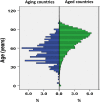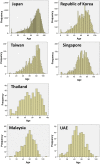Impact of population aging on the presentation of out-of-hospital cardiac arrest in the Pan Asian Resuscitation Outcomes Study
- PMID: 31988755
- PMCID: PMC6971460
- DOI: 10.1002/ams2.430
Impact of population aging on the presentation of out-of-hospital cardiac arrest in the Pan Asian Resuscitation Outcomes Study
Abstract
Aim: As a population ages, it can impact on the characteristics and outcomes of cardiogenic out-of-hospital cardiac arrest (OHCA) patients. This study aimed to evaluate the relationship between the age incidence of cardiogenic OHCA and population aging.
Methods: This was a post-hoc analysis of the Pan Asian Resuscitation Outcomes Study (PAROS) database. Data on the population old-age dependency ratio (i.e. elderly/non-elderly) were extracted from publicly accessible sources (United Nations and World Health Organization).
Results: We analyzed 40,872 OHCA cases from seven PAROS countries over the period 2009 to 2013. We found significant correlation between the population old-age dependency ratio and elderly/non-elderly ratio in OHCA patients (r = 0.92, P = 0.003). There was a significant correlation between the population old-age dependency ratio and risk differences of 30-day survival rates for non-elderly and elderly OHCA patients (r = 0.89, P = 0.007).
Conclusions: Our findings suggest that the proportion of elderly among OHCA patients will increase, and outcomes could increasingly differ between elderly and non-elderly as a society ages progressively. This has implications for planning and delivery of emergency services as a society ages.
Keywords: Aging; cardiac arrest; epidemiology; old‐age dependency ratio.
© 2019 The Authors. Acute Medicine & Surgery published by John Wiley & Sons Australia, Ltd on behalf of Japanese Association for Acute Medicine.
Figures




References
-
- Tanner R, Masterson S, Jensen M et al Out‐of‐hospital cardiac arrests in the older population in Ireland. Emerg. Med. J. 2017; 34: 659–64. - PubMed
-
- World_Health_Organization . Available from: http://apps.who.int/gho/data/view.main.SDG2016LEXv?xml:lang=en (last updated 03, Jan, 2019).
-
- Ong ME, Shin SD, De Souza NN et al Outcomes for out‐of‐hospital cardiac arrests across 7 countries in Asia: The Pan Asian Resuscitation Outcomes Study (PAROS). Resuscitation. 2015; 96: 100–8. - PubMed
-
- UNITED_NATIONS_DESA_POPULATION_DIVISION . Available from: https://esa.un.org/unpd/wpp/Download/Standard/Population/. (last updated 03 Jan 2019).
LinkOut - more resources
Full Text Sources
Research Materials

